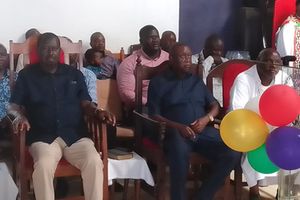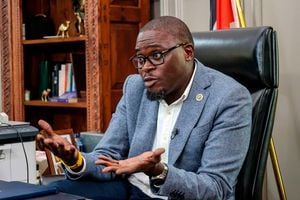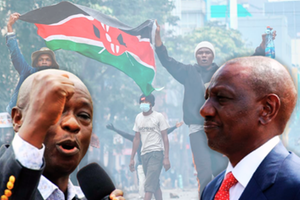Mysterious condition that paralyses one side of the face

Annita Raey at her home. Her right side of the face was paralysed as a result of bell's palsy.
What you need to know:
- Bell’s palsy is a condition where one side of the face becomes paralysed.
- The condition usually results from infection of the facial nerve that controls motor activities and muscles on one side of the face.
- These include infections from cold, herpes virus and sometimes HIV, diabetes, multiple sclerosis and Guillain barre syndrome. It may also be caused by high blood pressure.
“Most people know me as Annita Raey, but my official name is Hannah Gacau. My journey with bell’s palsy — a neurological disorder that causes paralysis or weakness on one side of the face — started this year. I started feeling unwell the first week of July.
I had just travelled back home from Kilifi. Our driver had been ailing from dengue fever and my colleagues thought that I had contracted the fever. And then I got a pimple on my lip.
A few days later, I decided to burst the pimple. The following morning, there were four pimples on my lip. My tonsils were hurting and I was in excruciating pain. I suspected I had a cold.
Eventually, I went to see a doctor. He told me that I had influenza and gave me medication. She also prescribed a cream to apply on the face, saying the pimples were spreading because I had touched my face.

Hannah Gacau during the interview on October 2. She is recovering from bells palsy.
I went back home, took the pills and applied the cream. When I woke up, the side of the face that had pimples was itchy, and I scratched it. I washed it again in the evening, applied the cream and went to sleep.
I woke up at 11pm in so much pain. The right side of the face was swollen and I couldn’t even open my eye. I also had blisters and a burning sensation on the face. I kept telling my sister that the vein on my right side of the head was going to burst and she would place something cold on it. It was a long night.
At 6am we went to hospital and the doctor said my blood pressure was extremely high. I couldn’t stand or speak. I received medication for pain and then started getting tested. The doctor said I had a viral infection and that they couldn’t figure out what it was. They, however, ruled out herpes virus that causes cold sores.
I was still in pain. The doctor said I should not have touched the wound — that I infected it by washing and that the cream is what led to the blisters. He also said I was at risk of getting paralysis because my blood pressure was not going down even after taking medication.
He said my nerves would get affected. My face was still swollen, but he promised that the swelling would stop once my nerves stopped reacting to the burn sensation.
I went home that Friday and slept. Since I had applied the cream from mouth to ear, the ear was also affected. I had an uneventful weekend during which the swelling completely went down. My face started going back to normal.
On Monday as I started making plans to travel back to Kilifi for work, my eye started tearing up and wouldn’t stop. The next morning the eye couldn’t close no matter how hard I tried to blink.
I also noticed that the right side of the face and eye was sagging. Thinking that it resulted from the prior swelling, I called the doctor, only for him to diagnose me with bell’s palsy through a video call.
I was also unable to move my right eyebrow or speak without my mouth shifting sideways. My sense of taste was gone and I couldn’t even suck water through a straw. My neck was stiff and surprisingly, I wasn’t in pain even though the doctor insisted that I should have been.
Regrettably, I ignored his call to go to hospital and finalised my plans to travel. It would be my worst train ride since I got a severe headache that would not go away even with painkillers. Upon arrival in Mombasa, my right side of the shoulder had gotten numb.
I went to see a doctor, who noticed that I was struggling with the right side of my body. His diagnosis was that I was in the process of getting a mild stroke and that the palsy was progressing towards the shoulder because I was doing nothing about it.
He referred me to a physiotherapist who massaged one spot on my shoulder for two hours to relax my nerves. It was the worst pain I have ever experienced.
The doctor explained that bell’s palsy is a condition which is both curable and incurable depending on various circumstances. He said in most cases, they have no idea what causes it, but that in my case, it was because my blood pressure went high and affected my nerves.
I needed steroids to stabilise my nerves. I also needed to do facial exercises and physiotherapy about four times in a day. I was put on medication with a warning that it was going to get worse before it got better. It did.
The next day I started getting spasms of pain that were crippling and I couldn’t move. They were random. I have had two children through natural birth, but nothing compares to the pain I felt.
I made plans to travel back home and went to see a different doctor.
He said I had had a mild stroke and that my nerves were damaged; and if we failed to manage them, they would affect other nerves. At this point my blood pressure was still high and my right eye still wouldn’t close.
I was on stroke medication and I struggled to eat. I fed on yoghurt for two weeks because my right mouth muscles were weak. I would drool while eating, necessitating that I drape a nappy around my neck and avoid eating in public. Eventually, I had to learn to eat with my left side.
During this period, my left eye also became ill as a result of straining. I developed a dry eye, a rough and itchy facial skin and an infected dry ear that had stopped producing wax. As a result, I was on multiple medication and using more than two ointments.
It was at this point that I realised the illness was serious. I decided to research and read about it. My body also started responding to medication and the pain spasms disappeared.
I continued with the facial exercises. I would try to raise my eyebrows, hold air in my mouth and blow multiple balloons to train my mouth muscles. I would poke out my tongue and constantly massage the right side of my face.
To raise awareness about the condition, I posted a picture showing my facial paralysis on X (formerly twitter). I received responses of people who had the condition but failed to see a doctor because they thought it was normal, that it would heal on its own, or they thought it was punishment for something wrong they did, or that they had been bewitched.
My family has been so supportive . Currently, my lip, where the pimples started and the teeth in that area, are sensitive, but I am healing.
The doctor said the sensitivity will disappear within two months and that my clinics should end by December. My blood pressure is also back to normal.
This condition changed me mentally, physically, spiritually and emotionally. But I have learnt a lot. I am more patient, calm and nothing fazes me."
Dr Sylvia Mbugua, a neurologist at Aga Khan University Hospital, explains that bell’s palsy is a condition where one side of the face becomes paralysed. The condition usually results from infection of the facial nerve that controls motor activities and muscles on one side of the face.
These include infections from cold, herpes virus and sometimes HIV, diabetes, multiple sclerosis and Guillain barre syndrome. It may also be caused by high blood pressure.
She adds that a person with the condition usually has trouble creasing their forehead. Their eye will also tear continuously and they may lose the ability to close the eye on the affected side of the face. They may also lose the sense of taste.
“When we detect the condition early, we put patients on steroids, analgesics and antiviral drugs for a five-day course. We also send them for physiotherapy to stimulate the facial nerves. We encourage them to do exercises such as chewing gum, blowing balloons and pursing their lips,” she says.
“There is no data in Kenya, partially because our people have poor health seeking behaviour. They may either fail to go to hospital or only visit local dispensaries that have no capacity to diagnose and treat the condition. I have seen only three patients in the past year,” she adds.
Alex Obuya, a physiotherapist and director at active Zone Physiotherapy and Sports Injuries Clinic, explains that physiotherapy helps to assess the severity of the weakness or the impact that bell’s palsy has caused to a patient’s daily life.
Once an assessment is done, muscle rehabilitation follows, which may involve a range of technique to treat the affected facial muscles.
The techniques include facial exercises, soft tissue manipulation and electric stimulation using transcutaneous nerve stimulation machine. The aim of the exercises is also to improve muscle strength, coordination of facial muscles and control of the affected side of the face.





